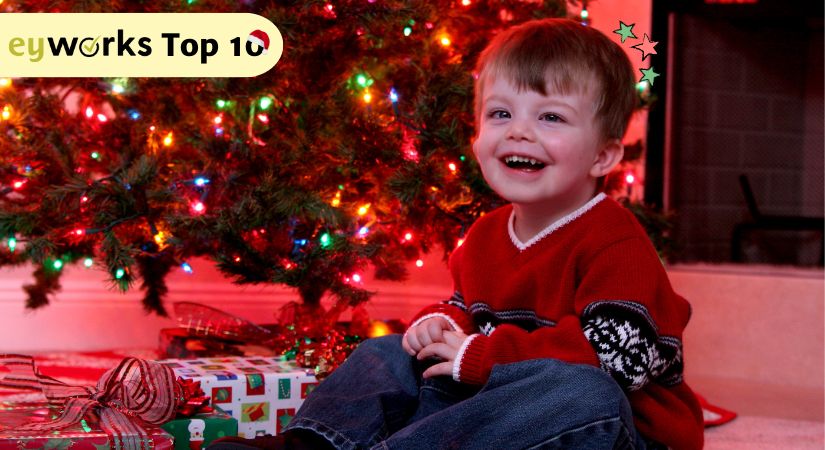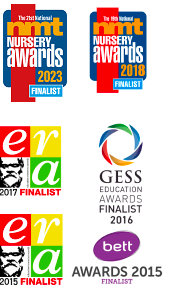Christmas is a magical time of year, especially for little ones! Whether you’re an Early Years practitioner, a parent, or a caregiver, it’s essential to create memorable experiences for the little tots during the festive season. In this blog, we’ve compiled a list of 10 Christmas activities suitable for both Toddlers and Babies in your setting. These activities not only spread holiday cheer but also contribute to their learning and development. We’ll also share tips on how to make them environmentally friendly, because sustainability matters.
Contents:
- Christmas Card Making
- DIY Snow Globes
- Sensory Snow Play
- Mini Christmas Tree Decorating
- Festive Dance Party
- Reindeer Food Making
- Christmas Light Show
- Snowy Obstacle Course
- Winter Ice Lollies
- Christmas Baking
Christmas Card Making
Help the little ones create personalised Christmas cards.
Setup:
For Babies:
Provide non-toxic, washable paint and help Babies make handprints or footprints on white folded cards. Guide their hands gently to create prints. Engage their senses by describing the sensation of the paint on their skin, using words like “cold” and “smooth.” Using pens and stickers, turn the Babies’ handprints and footprints into Christmassy items like reindeer for a fun Christmas Card to send home to friends and family.
For Toddlers:
Set up a crafting area with child-safe art materials for Toddlers to create their Christmas cards. Encourage them to explore making marks on the cards using crayons, markers, stickers, or even paint. Let them explore the tactile experience, and engage their senses through touch and colour. Engage them in conversation about the colours and shapes they’re using. For added fun, introduce safe, biodegradable glitter for some sparkle in their artwork.
Learning Benefits:
For Babies:
Sensory Exploration: The handprint and footprint art activity engages Babies’ sense of touch. Feeling the sensation of paint on their skin allows them to explore different tactile experiences, enhancing their sensory development.
Language Development: As caregivers describe the sensation of the paint on their skin using words like “soft” and “smooth,” Babies build their sensory vocabulary. They begin to associate words with their tactile experiences, promoting language development.
Fine Motor Skills: Guiding Babies’ hands to create handprints or footprints helps develop fine motor skills. They practice coordination and control as they make prints, contributing to their physical development.
Cognitive Development: Creating prints can introduce Babies to the concept of cause-and-effect. They learn that pressing their hand or foot onto the paper results in an imprint, which is an early understanding of cause and effect.
Bonding: Engaging in the activity with caregivers strengthens the emotional bond between Babies and caregivers. The close interaction, gentle guidance, and shared experience promote attachment and emotional connection.
For Toddlers:
Fine Motor Skills: Providing Toddlers with child-safe art materials allows them to develop fine motor skills. They practice hand-eye coordination, grip strength, and controlled movements as they make marks on the cards using crayons, markers, stickers, or paint.
Sensory Exploration: Toddlers actively engage in sensory exploration as they create Christmas cards. They can explore the textures and tactile sensations of the art materials, enhancing their sensory development.
Cognitive Development: Toddlers engage in cognitive processes such as creative thinking as they create their own Christmas cards. They experiment with different colours and shapes, fostering cognitive development.
Language Development: Encouraging Toddlers to talk about the colours and shapes they’re using promotes language development. They learn to express themselves, communicate their creative choices, and use descriptive words.
Creativity and Imagination: Making Christmas cards encourages Toddlers to use their creativity and imagination. They can invent their own designs, tell stories through their cards, and engage in imaginative play.
Social Interaction: Craft activities can be done in a group setting or with peers, encouraging social interaction and cooperation. Toddlers can share their creations, collaborate on card-making projects, and engage in parallel or cooperative play.
Problem-Solving: Toddlers may encounter creative challenges while making Christmas cards, such as deciding where to place stickers. This promotes problem-solving skills and creative thinking.
Eco-Friendly Tip: Use a variety of ‘scrap’ materials such as partially used paper to make the most out of the materials you already have.
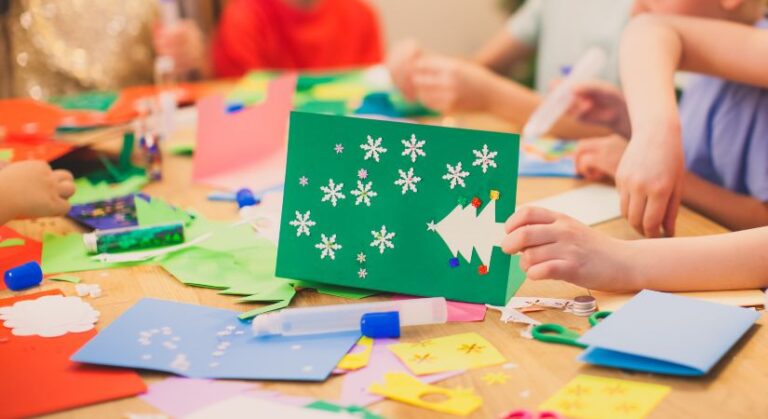
DIY Snow Globe
Create mini snow globes using jars or bottles, water, and glitter and let the children explore them!
Setup:
For Babies:
Place the sensory snow globes filled with water, glitter, and small Christmas-themed items on a soft blanket or playmat. Allow Babies to observe the snow globes, looking at the floating glitter and items inside. Describe the sparkling contents and how they move when shaken and encourage them to touch the snow globes gently.
For Toddlers:
Place the snow globes at a low table, allowing Toddlers to pick them up and shake them gently. Encourage them to interact with the snow globes, observing the glitter’s movement and describing what they see.
Learning Benefits:
For Babies:
Visual Stimulation: Snow globes filled with glitter and tiny figurines engage Babies’ visual senses. They can observe the sparkling glitter and objects inside, promoting visual development.
Sensory Exploration: Allowing Babies to touch and explore the snow globes gently provides sensory stimulation. They can feel the surface of the snow globes and listen to any sounds they make when moved.
Language Development: Describing the objects within the snow globes and how they move when shaken helps build Babies’ vocabulary. They begin to associate words with the sensory experiences they encounter.
Cognitive Development: Snow globes introduce Babies to the concept of cause-and-effect. They can learn that shaking the globe results in the movement of the glitter and figurines, contributing to their understanding of basic cause-and-effect relationships.
Sensory Awareness: Snow globes offer a multi-sensory experience, engaging visual, tactile, and auditory senses. Babies can explore the different sensory aspects of the globes, enhancing their sensory awareness.
For Toddlers:
Fine Motor Skills: Toddlers develop their fine motor skills as they pick up and shake the snow globes. The activity requires hand-eye coordination, grip strength, and controlled movements.
Observation and Description: Encouraging Toddlers to observe the snow globes and describe what they see promotes language development. They learn to express themselves and communicate their observations.
Cognitive Skills: Snow globes engage cognitive skills such as observation, analysis, and description. Toddlers can learn to identify the objects and describe the scenes inside the globes.
Sensory Awareness: Snow globes provide a rich sensory experience. Toddlers can observe the visual effects of the glitter and objects, feel the texture of the globes, and listen to the sounds they make when shaken, fostering sensory development.
Imagination: The scenes inside the snow globes can spark Toddlers’ imaginations. They may create stories or narratives related to the scenes they observe, fostering imaginative thinking.
Expressive Language: Encouraging Toddlers to describe what they observe in the snow globes promotes expressive language skills. They learn to communicate their thoughts and experiences effectively.
Attention and Focus: Manipulating snow globes can help Toddlers extend their attention span as they become more engaged in observing the visual effects and listening to descriptions.
Eco-Friendly Tip: Use reusable jars or bottles from your recycling and consider biodegradable glitter.
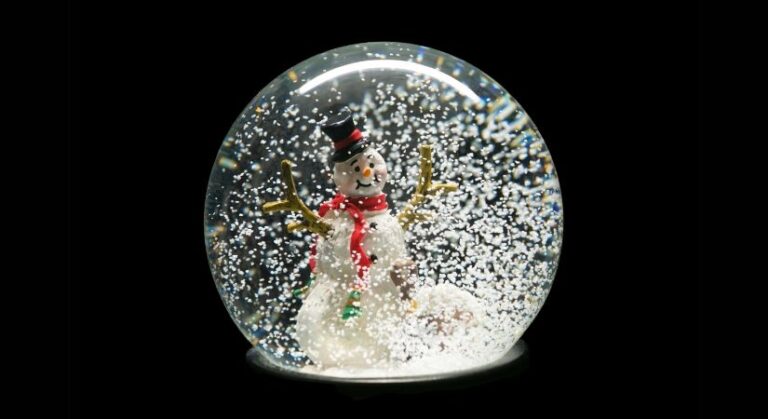
Sensory Snow Play
Mix 2 parts cornstarch with 1 part water for a snowy texture to play with.
Setup:
For Babies:
Set up a supervised sensory play area with a soft blanket or playmat. Place the snow-textured mixture within reach and let Babies touch and explore it. Describe the snow’s texture, using words like “soft” and “smooth” to engage their senses.
For Toddlers:
Create a designated sensory play area, possibly with a low table, for Toddlers to explore the snow-textured mixture. Encourage them to manipulate the material, shaping it, and experiencing different textures. Ask open-ended questions like, “What does the ‘snow’ feel like in your hands?” to spark their sensory exploration.
Learning Benefits:
For Babies:
Sensory Exploration: Providing a sensory play area with a snow-textured mixture offers Babies a tactile sensory experience. They can touch and explore the texture of the “snow,” enhancing their sensory development.
Tactile Stimulation: As Babies touch and manipulate the “snow,” they engage their sense of touch, and build their recognition of different sensations.
Visual Stimulation: Babies can visually explore the white, snowy texture of the material, promoting visual development.
Language Development: Describing the “snow” texture and sensory experiences with words like “soft” and “smooth” contributes to language development. Babies begin to associate words with their tactile experiences.
For Toddlers:
Fine Motor Skills: Manipulating the snow-textured mixture encourages the development of fine motor skills. Toddlers practice hand-eye coordination and finger dexterity as they shape and explore the material.
Sensory Exploration: Sensory play provides Toddlers with opportunities to explore different textures and sensations. Encouraging them to describe the “snow” texture using their own words fosters sensory awareness and vocabulary development.
Cognitive Development: As Toddlers engage in sensory play, they learn about the properties of materials and make connections between what they see and feel. They begin to understand the cause-and-effect relationship between their actions and the material’s response.
Expressive Language: Encouraging Toddlers to describe what the “snow” feels like in their hands promotes expressive language development. They learn to communicate their sensory experiences and use descriptive words.
Creativity and Imagination: Sensory play can spark Toddlers’ creativity and imaginative thinking. They may invent stories or scenarios related to the “snow,” fostering imaginative play.
Social Interaction: Sensory play activities can be done in a group or with peers, encouraging social interaction and cooperation. Toddlers can share their sensory discoveries and engage in parallel or cooperative play.
Eco-Friendly Tip: Try purchasing cornstarch from a zero-waste store, using reusable containers.
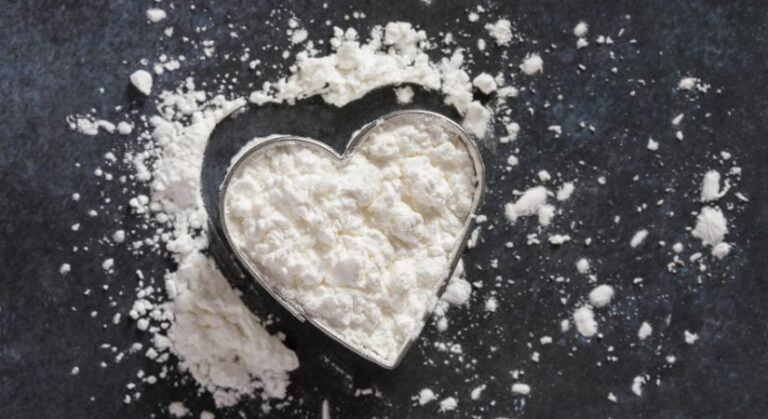
Mini Christmas Tree Decorating
Allow little hands to decorate small, artificial Christmas trees with child-safe ornaments.
Setup:
For Babies:
Place small, artificial Christmas trees on a soft blanket or playmat within their reach. Let Babies touch the trees and observe the colourful, child-safe ornaments. Describe the ornaments’ colours and shapes to engage their senses.
For Toddlers:
Set up a decorating station with small Christmas trees on a low table or play area. Provide child-safe, easy-to-grasp ornaments and encourage Toddlers to hang them on the trees. Engage them in conversation by asking questions like, “Can you put the red ornament on the tree?” to encourage fine motor skills and language development.
Learning Benefits:
For Babies:
Sensory Exploration: The presence of small Christmas trees allows Babies to engage in sensory exploration. They can touch and feel the trees, exploring their textures and shapes, which contributes to sensory development.
Visual Stimulation: The colourful, child-safe ornaments on the trees engage Babies’ visual senses. They can observe the ornaments, promoting visual development.
Language Development: Describing the colours and shapes of the ornaments engages Babies’ auditory senses and language development. They begin to associate words with the sensory experiences and visual attributes.
For Toddlers:
Fine Motor Skills: Decorating small Christmas trees with ornaments promotes the development of fine motor skills. Toddlers practice hand-eye coordination and finger dexterity as they grasp and hang the ornaments on the trees.
Sensory Exploration: Sensory play encourages Toddlers to explore different textures and shapes of the trees and ornaments. Encouraging them to describe the colours, textures, and shapes of the ornaments builds sensory awareness and vocabulary.
Cognitive Development: As Toddlers decorate the trees, they engage in cognitive processes such as decision-making and spatial awareness. They must choose where to place each ornament and understand how it fits on the tree.
Language Development: Encouraging Toddlers to participate in conversations about decorating the trees promotes language development. They learn to express themselves, follow instructions, and communicate their creative choices.
Creativity and Imagination: Decorating small Christmas trees allows Toddlers to use their creativity and imagination. They can decide where to place each ornament, invent stories about the trees, and create their own festive scenes.
Problem-Solving: Toddlers may encounter challenges when trying to hang ornaments. This promotes problem-solving skills as they figure out how to place the ornaments on the trees.
Social Interaction: Decorating activities can be done in a group or with peers, encouraging social interaction and cooperation. Toddlers can share ideas, collaborate on decorating, and engage in parallel or cooperative play.
Eco-Friendly Tip: Try to source second-hand reusable Christmas trees and decorations to reduce their carbon impact.
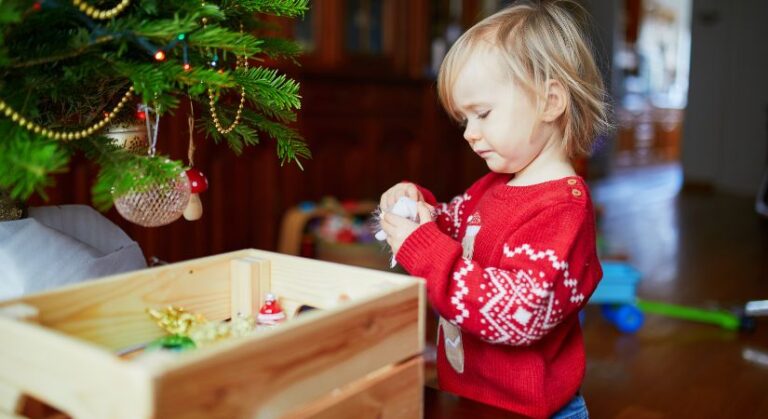
Festive Dance Party
Sing and dance along to festive songs together, with jingle bells for added fun.
Setup:
For Babies:
Gather Babies in a comfortable space with soft blankets or cushions. Play festive music with jingle bells in the background. Allow them to hear the music and watch others dance, describing the sounds and movements.
For Toddlers:
Create a festive atmosphere for Toddlers to participate in a sing and dance-along. Hand out jingle bells or other noisy instruments for them to shake along to the music, creating a multisensory experience. Encourage them to move to the rhythm of the music, fostering their gross motor skills.
Learning Benefits:
For Babies:
Auditory Stimulation: Creating a space with festive music allows Babies to engage in auditory stimulation. They can listen to the music and become familiar with different tones, rhythms, and sounds, which contributes to their auditory development.
Sensory Engagement: Being in a comfortable space with soft blankets or cushions offers a sensory experience for Babies. They can feel the textures and enjoy the comfort, enhancing their sensory development.
Language Development: Describing the sounds and movements of the music and dance to Babies promotes language development. They begin to associate words with auditory and visual attributes.
Rhythmic Awareness: Listening to music introduces Babies to rhythm and beat. They can feel the natural rhythm of the music, which is a precursor to developing a sense of rhythm and musical understanding.
Cognitive Development: Babies start to build early cognitive skills as they listen to the music and watch the movements of dancers. They may learn to associate the rhythm of the music with physical actions.
Bonding: Interacting with Babies in a cosy area while they listen to music and watch others dance strengthens the emotional bond between Babies and caregivers. The shared sensory experience and close interaction promote attachment and emotional connection.
Visual Stimulation: Allowing Babies to watch others dance and move to the music engages their visual senses. They can observe the movements and actions of those dancing, promoting early visual development and object recognition.
For Toddlers:
Auditory Stimulation: Providing a dance area with festive music actively engages Toddlers’ auditory senses. They can actively participate in auditory stimulation by listening to the music and learning to recognize different rhythms and beats.
Sensory Exploration: The multisensory experience of holding and shaking noisy instruments while listening to music engages multiple senses. Toddlers can explore the tactile sensation of holding the bells and the auditory sensation of the sounds they produce.
Language Development: Engaging Toddlers in a sing-along allows them to participate vocally, which promotes language development. They learn to sing along with the music, express themselves, and communicate through song.
Rhythmic and Musical Awareness: Toddlers can develop a better sense of rhythm and musical awareness as they move and shake to the beat of the music. This activity fosters an early appreciation for music.
Gross Motor Skills: Encouraging Toddlers to move and groove to the music promotes gross motor skill development. They practice coordination, balance, and rhythmic movement as they dance and clap their hands.
Social Interaction: Dancing and singing can be done in a group setting or with peers, encouraging social interaction and cooperation. Toddlers can share their dance moves, collaborate on dance routines, and engage in group play.
Expressive Movement: Toddlers can express themselves through movement as they dance, sway, or shake to the music. This activity allows them to convey their emotions and feelings through physical expression.
Cognitive Development: Toddlers continue to build cognitive skills as they engage with the music and dance. They may learn to anticipate changes in the music and understand cause-and-effect relationships related to their movements.
Eco-Friendly Tip: Make your own noisy instruments using recycled materials such as bottles and rice for shakers.

Reindeer Food Making
Mix oats, birdseed, and edible glitter for a reindeer treat.
Setup:
For Babies:
Show Babies the ingredients for reindeer food, emphasizing the different textures. Let them touch the oats, birdseed, and edible glitter. Describe the sensory experience with words like “crunchy” and “shiny.”
For Toddlers:
Set up a safe, supervised space for Toddlers to participate in making reindeer food. Provide bowls with the ingredients and let them explore by mixing and touching the different textures, and then using spoons to put the mixture into little bags to take home. Engage them in a conversation by asking questions like, “What does the birdseed feel like in your hand?” to promote sensory exploration.
Learning Benefits:
For Babies:
Sensory Exploration: Showing Babies the ingredients for reindeer food introduces them to sensory exploration. They can touch and feel the oats, birdseed, and edible glitter, promoting tactile sensory experiences.
Visual Stimulation: Babies can visually explore the ingredients, observing the textures and the glitter’s shine, which promotes visual development.
Language Development: Describing the ingredients and sensory experiences with words engages Babies’ auditory senses and language development. They begin to associate words with the sensory attributes of the ingredients.
Bonding: Interacting with caregivers while exploring the ingredients strengthens the emotional bond between Babies and caregivers. The shared sensory experience promotes attachment and emotional connection.
For Toddlers:
Sensory Exploration: Providing Toddlers with a space to participate in making reindeer food allows them to actively engage in sensory exploration. They can touch, mix, and feel the different textures of the ingredients, enhancing their sensory development.
Cognitive Development: Mixing and exploring the ingredients fosters cognitive development. Toddlers learn about the properties of different materials, and they experiment with mixing and combining elements, promoting early problem-solving skills.
Language Development: Engaging Toddlers in conversation while they make reindeer food promotes language development. They learn to express themselves, communicate their sensory experiences, and answer questions, building their vocabulary and communication skills.
Fine Motor Skills: Toddlers develop fine motor skills as they manipulate the ingredients, pouring, mixing, and touching. These actions involve hand-eye coordination, finger dexterity, and control.
Creativity: Making reindeer food encourages Toddlers to use their creativity and imagination. They can experiment with the ingredients, invent their own mixtures, and engage in imaginative play.
Social Interaction: The activity can be done in a group or with peers, encouraging social interaction and cooperation. Toddlers can share their sensory discoveries, collaborate on making reindeer food, and engage in cooperative play.
Eco-Friendly Tip: Encourage wildlife-friendly practices by including birdseed and other wildflower seeds in your mix.
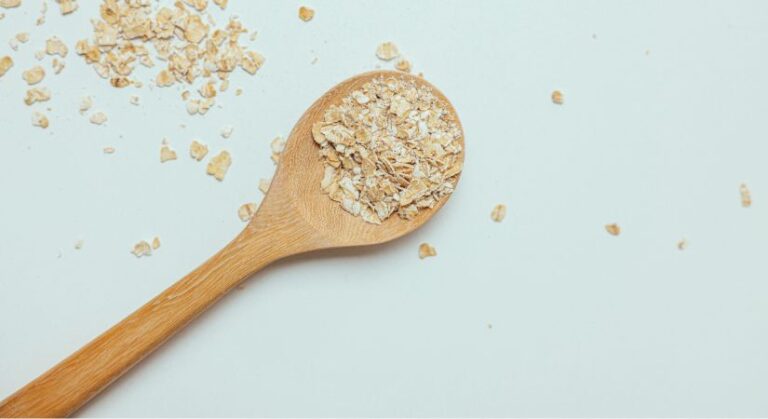
Christmas Light Show
Create a mesmerizing light show with Christmassy lights in a darkened room.
Setup:
For Babies:
Set up a cosy area with soft blankets or cushions and create a mesmerizing light show with fairy lights and projections. Let Babies watch the twinkling lights and describe the colours and patterns to engage their visual senses. Play some music along with the light show to provide auditory stimulation.
For Toddlers:
Provide a safe space for Toddlers to interact with the lights. Encourage them to observe the lights and maybe even play with child-safe, battery-operated lights. Engage in conversation about the light show by asking questions like, “What colours do you see?”
Learning Benefits:
For Babies:
Visual Stimulation: Setting up a cosy area with colourful lights and letting Babies watch the lights engages their visual senses. They can focus on the lights and the changing colours and patterns, promoting visual development.
Auditory Stimulation: If the lights include soft, soothing music, Babies also receive auditory stimulation, which complements the visual experience. This dual sensory input can enhance their sensory development.
Cognitive Development: Babies begin to build early cognitive skills as they observe and track the lights. They learn about cause and effect as they see the lights change and move.
Language Development: Describing the colours and patterns of the lights to Babies helps build their auditory vocabulary. They begin to associate words with the visual attributes of the lights.
Bonding: Interacting with Babies in a cosy area while they watch the light show strengthens the emotional bond between Babies and caregivers. The shared experience and close interaction promote attachment and emotional connection.
For Toddlers:
Visual Stimulation: Encouraging Toddlers to interact with the lights actively engages their visual senses. They can observe the lights and the colours and patterns while developing their visual acuity.
Auditory Stimulation: If music accompanies the light show, Toddlers receive auditory stimulation. This multisensory experience allows them to explore both auditory and visual senses.
Cognitive Development: Toddlers continue to build cognitive skills as they watch and interact with the lights. They may learn to anticipate changes in the light patterns and understand cause-and-effect relationships.
Language Development: Engaging in conversation about the light show promotes language development for Toddlers. They learn to express their observations, describe what they see, and communicate their thoughts.
Fine Motor Skills: Toddlers may practice fine motor skills if they are encouraged to manipulate child-safe, battery-operated lights. Handling these lights involves hand-eye coordination and controlled movements.
Sensory Awareness: The light show encourages sensory awareness as Toddlers explore the changing colours and patterns. They develop a deeper understanding of visual stimuli and how light can create different sensory experiences.
Creativity and Imagination: Toddlers may use their creativity and imagination to interpret and engage with the light show. They may tell stories, create narratives, or invent their own games related to the lights.
Eco-Friendly Tip: Opt for energy-efficient LED lights

Snowy Obstacle Course
Create a winter-themed obstacle course using cushions, tunnels, and soft play equipment.
Setup:
For Babies:
Create a safe, padded obstacle course using cushions and soft play equipment. Allow Babies to explore the soft obstacles within their safe space. Describe the textures and shapes of the cushions.
For Toddlers:
Set up a low obstacle course with soft play equipment. Encourage Toddlers to crawl through tunnels, climb over soft obstacles, and engage in gross motor play. Use descriptive words like “bumpy” or “squishy” to enhance their sensory exploration.
Learning Benefits:
For Babies:
Sensory Exploration: Creating a safe obstacle course with cushions and soft play equipment allows Babies to engage in sensory exploration. They can touch and feel the textures of the cushions and soft obstacles, promoting tactile sensory experiences.
Visual Stimulation: Babies can visually explore the shapes and colours of the cushions and soft play equipment. This visual engagement promotes early visual development.
Auditory Stimulation: Describing the textures and shapes to Babies using words engages their auditory senses and language development. They begin to associate words with the sensory attributes of the obstacles.
Cognitive Development: Babies start to build early cognitive skills as they navigate the obstacle course. They learn about spatial relationships, distances, and basic problem-solving as they move through the soft obstacles.
Bonding: Interacting with Babies within the obstacle course area strengthens the emotional bond between Babies and caregivers. The shared sensory experience and close interaction promote attachment and emotional connection.
For Toddlers:
Gross Motor Skills: The low obstacle course with soft play equipment encourages Toddlers to engage in gross motor play. They crawl through tunnels, climb over soft obstacles, and practice balance and coordination, promoting gross motor skill development.
Sensory Exploration: Toddlers actively engage in sensory exploration as they navigate the obstacle course. They can feel the textures, bumps, and shapes of the soft obstacles, enhancing their sensory development.
Cognitive Development: Navigating the obstacle course fosters cognitive development. Toddlers learn about spatial relationships, cause and effect, and problem-solving as they move through the soft obstacles.
Language Development: Engaging Toddlers in conversation during the obstacle course promotes language development. They learn to express themselves, communicate their observations, and answer questions, building their vocabulary and communication skills.
Social Interaction: Gross motor play can be done in a group setting or with peers, encouraging social interaction and cooperation. Toddlers can share their experiences, collaborate on navigating the course, and engage in parallel or cooperative play.
Balance and Coordination: Climbing and crawling over soft obstacles require balance and coordination. Toddlers practice these skills as they move through the course, which contributes to their physical development.
Eco-Friendly Tip: Re-use the equipment you already have in the setting, try scrap materials for making Chrismassy decorations.
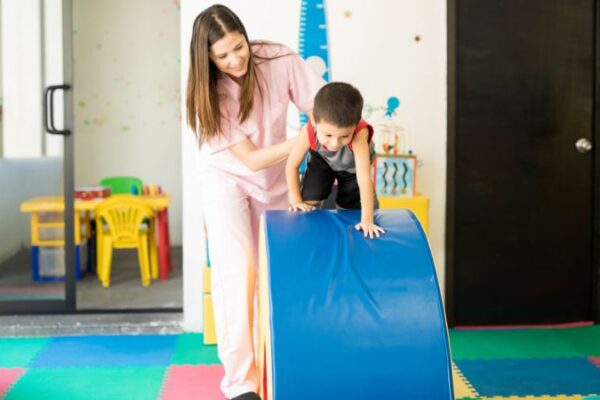
Winter Ice Lollies
Freeze water and edible glitter to explore a sensory sensation!
Setup:
For Babies:
Show Babies the Ice Lollies and describe their sparkly appearance. Allow them to touch and explore the Ice Lollies while emphasizing the sensory experience.
For Toddlers:
Place the Ice Lollies in a safe space for Toddlers to hold and explore. Encourage them to touch and feel the coldness of the Ice Lollies, describing their texture and visual appeal. Talk about what happens to the ice when it gets warm and is no longer frozen.
Learning Benefits:
For Babies:
Visual Stimulation: Showing Babies the Ice Lollies engages their visual senses. They can focus on the sparkly appearance of the Ice Lollies, promoting early visual development and object recognition.
Sensory Exploration: Babies begin to build sensory awareness as they interact with the Ice Lollies. They experience the sensation of coldness and explore different textures, which contributes to sensory development.
Language Development: Describing the sparkly appearance and sensory experience of the Ice Lollies to Babies helps build their auditory vocabulary. They begin to associate words with sensory attributes.
Bonding: Interacting with Babies while they explore the Ice Lollies strengthens the emotional bond between Babies and caregivers. The shared sensory experience and close interaction promote attachment and emotional connection.
For Toddlers:
Sensory Exploration: Toddlers continue to build sensory awareness as they interact with the Ice Lollies. They experience the sensation of coldness and explore the tactile and visual qualities of the Ice Lollies, enhancing sensory development.
Visual Stimulation: Engaging Toddlers with the visual appeal of the snowflake Ice Lollies enhances their visual development. They observe the sparkly appearance and details of the Ice Lollies while developing their visual acuity.
Cognitive Development: Toddlers engage in cognitive processes as they explore the Ice Lollies. They may learn about temperature differences (coldness), cause and effect (touching the Ice Lollies), and basic sensory experiences.
Language Development: Encouraging Toddlers to talk about the texture and visual appeal of the Ice Lollies promotes language development. They learn to express themselves, communicate their sensory experiences, and use descriptive words effectively.
Fine Motor Skills: Holding and exploring the Ice Lollies requires fine motor skills. Toddlers practice hand-eye coordination, grip strength, and controlled movements as they handle the icy treats.
Eco-Friendly Tip: Recycle old yoghurt pots by turning them into moulds for your ice lollieSe
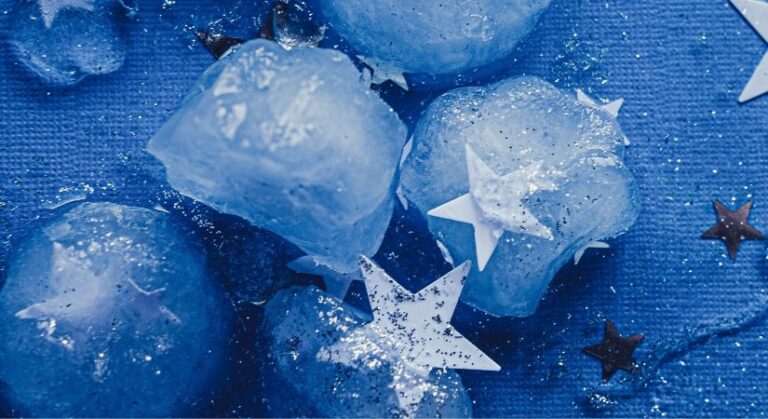
Christmas Baking
Bake simple Christmas treats, like gingerbread cookies or mince pies.
Setup:
For Babies:
For baking activities with Babies, safety is the primary concern. Babies should be in a secure environment where they can observe the baking process. You can set up a safe area in the kitchen, away from the cooking zone, and provide them with a highchair or playpen. As you bake gingerbread cookies or mince pies, describe the scents and the ingredients, like cinnamon and sugar. Babies can watch and listen as you bake, engaging their senses through observation. They can then try the baked goods after all the cooking is done, helping them develop a diverse taste palete.
For Toddlers:
For Toddlers, you can create a designated baking area where they can participate in age-appropriate baking activities. Use safe, child-friendly utensils and non-toxic ingredients. Allow them to help with simple tasks like mixing ingredients, using cookie cutters, or adding decorations. Describe the sensory experience of touching and smelling the ingredients, such as the texture of the cookie dough or the aroma of spices. Encourage them to engage in hands-on baking with your guidance.
Learning Benefits:
For Babies:
Sensory Exploration: Creating a safe environment where Babies can observe the baking process allows them to engage in sensory exploration. They can watch and listen as you bake, promoting early sensory development.
Auditory Stimulation: Babies can listen to the sounds of baking, such as mixing, the oven timer, and sizzling. Describing these sounds to them fosters auditory stimulation and language development.
Language Development: Describing the scents and ingredients, like cinnamon and sugar, during the baking process promotes language development. Babies begin to associate words with sensory attributes and actions.
Visual Stimulation: Babies visually explore the baking process, observing the ingredients and actions involved. This visual engagement contributes to their early visual development.
Bonding: Interacting with Babies in a safe environment while you bake strengthens the emotional bond between Babies and caregivers. The shared sensory experience and close interaction promote attachment and emotional connection.
Taste Exploration: Introducing babies to a variety of foods helps them develop a diverse palate. They can learn to distinguish between sweet and salty flavours, laying the foundation for healthy eating habits.
For Toddlers:
Hands-on Learning: Creating a designated baking area for Toddlers to participate in baking activities allows them to engage in hands-on learning. They can practice fine motor skills, such as mixing, cutting shapes, or adding decorations.
Sensory Exploration: Toddlers continue to build sensory awareness as they actively participate in baking. They touch, feel, and smell the ingredients, promoting tactile and olfactory sensory development.
Auditory Stimulation: Toddlers can actively participate in baking, creating auditory experiences related to the sounds of mixing, rolling, or baking. They learn to associate sounds with actions and processes.
Language Development: Encouraging Toddlers to engage in baking and describing the scents, textures, and ingredients fosters language development. They learn to express themselves, communicate their thoughts, and use descriptive words effectively.
Cognitive Development: Toddlers engage in cognitive processes as they follow age-appropriate baking tasks. They may learn about sequencing, cause and effect, and basic problem-solving related to baking.
Creativity and Imagination: Toddlers can use their creativity and imagination to add personal touches to their baked creations. They may invent stories or narratives related to their baking projects.
Fine Motor Skills: Participating in baking activities involves fine motor skills. Toddlers practice hand-eye coordination, grip strength, and controlled movements as they handle utensils, ingredients, and decorations.
Pride and Self-Expression: Completing baking projects can boost Toddlers’ self-esteem and sense of accomplishment. They express themselves through their culinary creations and take pride in their baking endeavours.
Eco-Friendly Tip: Try using organic and locally sourced ingredients.
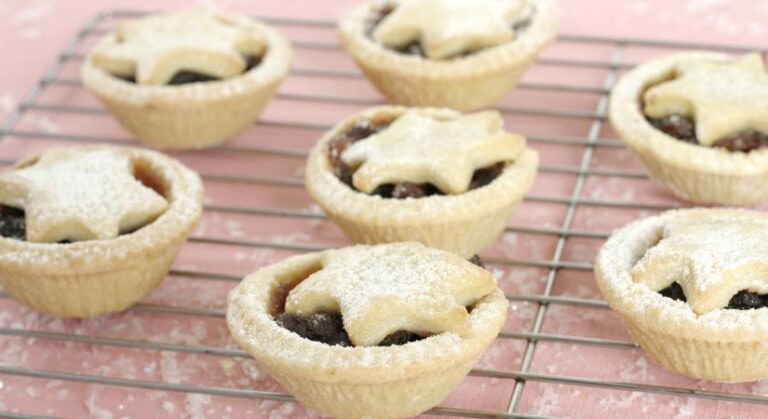
These Christmas activities are not only a whole lot of fun but also provide ample learning opportunities for your little ones. By incorporating environmentally friendly practices, we can ensure that these festive moments have a positive impact on both the children and the planet. Happy holidays and happy learning!
